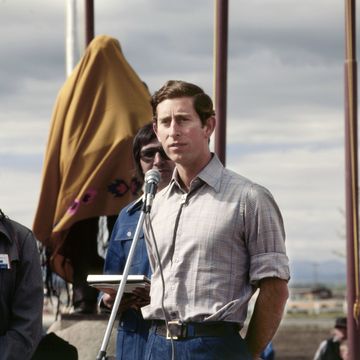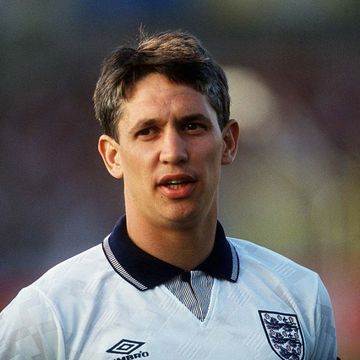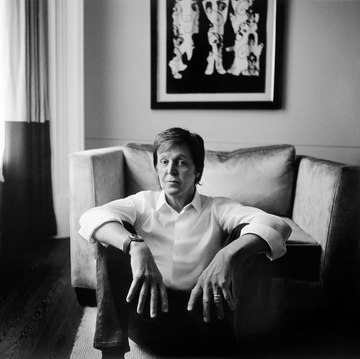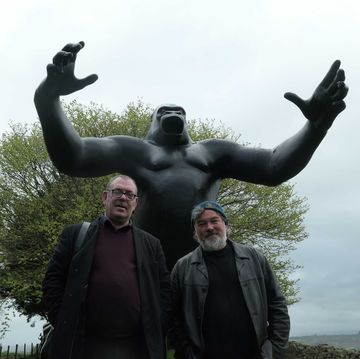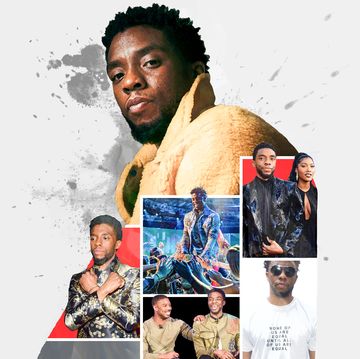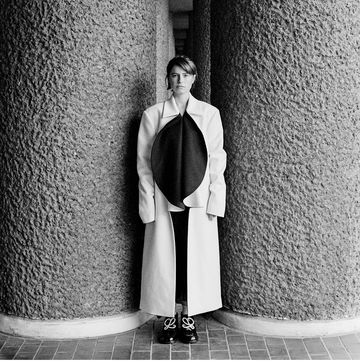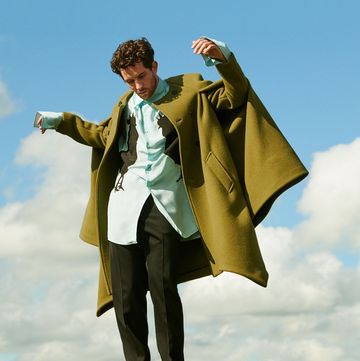A few years ago, I had the pleasure of interviewing Tom Ford about his film A Single Man. Ford, as we know, is a very stylish man, and an amusing one, and the film reflects his fastidious attention to detail. George Falconer, the college professor and the single man of the title, wears a suit made by Savile Row tailors Anderson & Shepherd, Ford's favourite tailor (it's an unusual college professor, one thinks, who could afford that). Following the firm's tradition, Ford took the pains to have the name of the fictional character and a fictional date on which the suit was delivered — George Falconer: August, 1957 — sewn on a label on the inside pocket of the jacket where, of course, absolutely no one would see it.
In the course of our discussion of all this and much more, Ford, unable to constrain his perfectionism a moment longer, suddenly leaned across and undid the fourth button on the cuff of my suit — "a style affectation," he explained, "that shows everybody that your buttons actually function." He then pointed out to me that I was committing the major sartorial infraction of wearing socks that were short enough to reveal a millimetre of flesh whenever I crossed my legs. When I told him the socks were from Marks & Spencer his silence was the cold, savage kiss of fashion death.
Tom Ford is probably the most calculatedly stylish man in the world. He owns his own fashion label. He lives in a Richard Neutra house. He wears calf-length socks. But is Tom Ford an exemplar of male style and cool? To some people perhaps, but socks and cuffs notwithstanding, not to me.
So who then are the true icons of male style and cool? One thinks of the perennial Steve McQueen, of course. Then there's Marlon Brando, James Dean, Frank Sinatra, Miles Davis, Muhammad Ali, and we mustn't forget David Bowie. You will have noticed the pattern... But let us turn to the living. Well there's... erm. Ah... And what about...? OK, you choose….
Certain men have traditionally stood out as stalwarts of style. From Hollywood: Humphrey Bogart, Fred Astaire and, less often celebrated, Gregory Peck, a model of discrete, expensively-cut good taste. One of Peck's favourite items was a Huntsman cashmere-tweed jacket in dark green-and-black dogtooth, made for him in 1960 from fabric woven on the Isle of Islay in the Inner Hebrides. According to his son Anthony, Peck would wear the tweed to "night games at Dodger Stadium, on walks in Central Park and down the Champs-Élysées." Well, who wouldn't?
From the world of letters, there is Tom Wolfe and Gay Talese — the Twin Towers of The New Journalism — both now well into their eighties, and who for the last 60 years seem to have been engaged in a private battle to out-dandy each other: Wolfe in his ubiquitous white suits, Talese with his wardrobe of immaculately cut three-piece suits, his co-respondent shoes and his complicated system of matching fabrics, patterns and colours with seasons and times of the day. We can do little but stand in open-mouthed admiration at such relentless perfectionism and, if we were wearing them, doff our hats (of which Talese has a collection of some 60 fedoras to chose from, kept in their own storage space in his Manhattan townhouse, shrink-wrapped and individually labelled: "Bogota, 1976" and so on).
Thinking of the world of rock, there is really only one place to start. And stop. There is an arresting picture from the late Sixties that shows Mick Jagger and Keith Richards at an airport, with Richards' girlfriend of the time, Anita Pallenberg. Jagger is wearing a velvet jacket, a white shirt (perhaps it's ivory) with a ruffled front and cuffs, a long scarf thrown carelessly around his neck (that Aristide Bruant poster look that was so popular in the Sixties). Even the magazine he is carrying is a style accessory, Paris Match with Johnny Hallyday, the French Elvis, on the cover.
Richards is wearing a funereal overcoat, a fur stole on his shoulders of the kind worn by eccentric Park Avenue heiresses in Weegee photographs, snakeskin boots, precisely the kind of look that would attract a girl like Pallenberg who, draped in velvet and furs, looks like $10m. All three — a crucial detail — are wearing wide-brimmed fedora hats. It's a look that defines a particular kind of renegade cool, the archetypal style template of sex, drugs and rock 'n' roll, much imitated but never surpassed, but now fixed irrevocably at a moment in time, as archaic in its own way as a top hat and spats.
Keith, of course, today still looks like Keith, with his death's-head ring, rasta-coloured headbands and spangled star shirts, the pantomime costume of an old rock 'n' roll vaudevillian. It's a look that screams, "don't try this at home, kids", because nobody else in the world could wear it without looking as if they were trying to be Keith. But looking at the Stones now, what is apparent is what many of us have long believed, that for all those years we were looking at the wrong man, and that the coolest person in the band was not Keith at all but the quiet geezer sitting at the back of the stage, drummer Charlie Watts. I spied him recently, late at night at Gatwick airport, a small, elderly man decanted from easyJet, dressed in an overcoat and carrying an overnight bag, passing unrecognised across the concourse, yet possessed of an inimitable style and bearing.
I grew up in an age when the exemplars of manly virtue were brilliantined sportsmen, or war heroes. People like Guy Gibson VC, DFC and Bar, DSO and Bar, the first commanding officer of the RAF's 617 Squadron, later immortalised in the film The Dambusters, and who died in a September 1944 plane crash when he was just 26. Gibson smoked a pipe and had a pet black labrador dog he named Nigger, a fact which, bizarrely, no-one at the time seemed to think the least bit odd or offensive. This, one was led to believe, was the kind of man a boy should aspire to be: noble, brave, self-sacrificing and utterly conventional in outlook and demeanour. And then along came The Rolling Stones… so who represents "manhood" now?
The most interesting masculine symbol in recent times has been Don Draper, the anti-hero of Mad Men. Much of the appeal of that series lay in its depiction of an altogether more reckless, unsanitised — and unbuttoned — era. The endless chain of cigarettes, the industrial quantities of liquor, the cavalier treatment of women… there is something thrillingly transgressive about Draper, and that's before we've even begun to consider the square-jawed good looks, the classic Brooks Brothers suits and sports jackets, ties and pocket squares, the London Fog raincoat. One of the most arresting things about Mad Men is that the series made no attempt to soften its central character, to make him a paragon of progressive attitudes in a sea of chauvinism and bad behaviour. In an age when men are constantly under siege for being "sexist", or being told to check their privilege, or to get in touch with their inner feelings, Draper crashes through other people's lives like a bulldozer, keeping a lid on his feelings until they threaten to burst.
Draper represents a particular archetype of masculinity; the Type A personality, driven, professional, in control. But the carapace of smooth self-confidence and the immaculate style can't disguise the mess of the man underneath. Jon Hamm, the actor who plays Draper, once expressed surprise at the number of people over the years who've told him, "I want to be just like Don Draper." "I'm like, 'You want to be a miserable drunk? I don't think you want to be anything like that guy. You want to be like the guy on a poster maybe, but not the actual guy.'"
For many, Steve McQueen is the paragon of cool masculinity. McQueen liked Harrington jackets, chunky knitwear and desert boots. You would search high and wide to find a picture of him in a suit. He did not have style but what he had, in spades, was cool. Reform school and a stint in the US Marines had endowed McQueen with an air of toughness and self-containment. He loved fast cars, motorcycles and aeroplanes. He was a limited actor but his best-known roles suggested he was his own man and nobody else's, someone who was never going to be told what to do by anybody. We admire the Steve McQueen in Bullitt (1968). But as is the case with all actors, we never had the opportunity to get close enough to know whether we'd have admired the man playing the role.
As we know, style has little to do with fashion. Nothing ages faster than fashion; style lasts forever. And one of the problems in trying to define who are today's icons of cool and style is that fashion has taken over. Nowadays, it is almost a mandatory requirement for any male figure of distinction and achievement to be signed up as a figurehead for this fashion brand or an ambassador for that one. The reason Idris Elba, or Colin Farrell, or pretty much any actor you care to name, always looks good in magazines is because the fashion editor has styled them that way.
And death offers no protection. Barbour International had an SS '16 Steve McQueen Collection, "a powerful compilation that celebrates an iconic figure in history" but that, one suspects, the famous biker jacket notwithstanding, McQueen himself would never have worn. Particularly T-shirts with his own image plastered on the front.
Would Marlon Brando, Frank Sinatra or Muhammad Ali have shilled for fashion labels? It's hard to believe it.
One of my earliest literary heroes — and I still maintain reading On the Road should be an essential part of every young man's rite of passage — was Jack Kerouac. I suspect few people cared less about how he dressed than Kerouac but that was not enough to save him, in 1993, from being co-opted by Gap Inc in an image of him, licensed from his estate, promoting chinos under the tag "Kerouac wore khakis". Of course, what Gap was trying to do was make a connection between their (mass-produced) chinos and the celebration of free-thinking individuality that the Beats in general, and Kerouac in particular, were perceived to embody: "mad to live, mad to talk, mad to be saved, desirous of everything at the same time," as Kerouac wrote.
The Gap advert was a curious fulfilment of a prophesy Kerouac himself had made, writing in a Playboy essay in June 1959 about the way that Beat style and manners would inevitably be swept up in the restless tide of fashion, with smooth professionals "coming out nattily attired in Brooks Brothers jean-type tailoring and sweater-type pull-ons, in other words, it's a simple change in fashion and manners, just a history crust... Beat comes out, actually, of old American whoopee and it will only change a few dresses and pants and make chairs useless in the living room." Kerouac also wrote, "great things are not accomplished by those who yield to trends and fads and popular opinion." I don't think he was writing about the width of a lapel or the drape of a jacket, but the same principle applies.
The photograph of Kerouac in Gap's ad was taken on the streets of New York, at around the time Kerouac wrote those words, a time when he was battling alcoholism, disillusioned and embittered by being fêted as "the king of the Beats" — a moniker he, of course, hated. In the end, no amount of cool, no amount of style could save him. Kerouac died in 1969 aged 47, a broken man.
So, where do we look now? There are unquestionably stylish people to be found. In the world of acting, there is George Clooney, a man who in his leisurely, unostentatious way oozes class. And people speak admiringly of Ryan Gosling's wardrobe. David Beckham is a nice man, I'm sure, and an admirable ambassador for the beautiful game. But an icon and model of cool? Really? Really? If we want to be perverse about this, my vote in the footballing world would go to Jürgen Klopp, with his accident-prone spectacles, his shocking dental work and his standard-issue kit sponsor's tracksuit; no magazine on earth is ever going to ask him to model Prada or Burberry, but there is something delightfully singular about Klopp; and is there a football fan in the country right now who does not secretly wish he was managing their team? And what about Grayson Perry, a man of wit, intelligence and commendable self-assurance, who can brush up nicely when the occasion demands it, although the brightly coloured appliquéd frock and Little Bo Beep shoes is not a look to suit every man.
Surely, surely, there must be someone still among us who fits the bill, a model of sartorial style and masculinity that any man can aspire to. And then it came to me. An artist, a poet and a ladies' man (notwithstanding the fact he once recorded an album declaring the death of that appellation). A man of courtly manners and bearing, of erudition and wisdom. A famous blue raincoat. An adherence to the dark suit, which he wore every day, even if he was only planning on a little house cleaning. And a fedora. Leonard Cohen, of course. A living exemplar. And then, as I sat down to write this, he too passed. Buried, no doubt in a suit. I just hope the fourth cuff button was undone.



